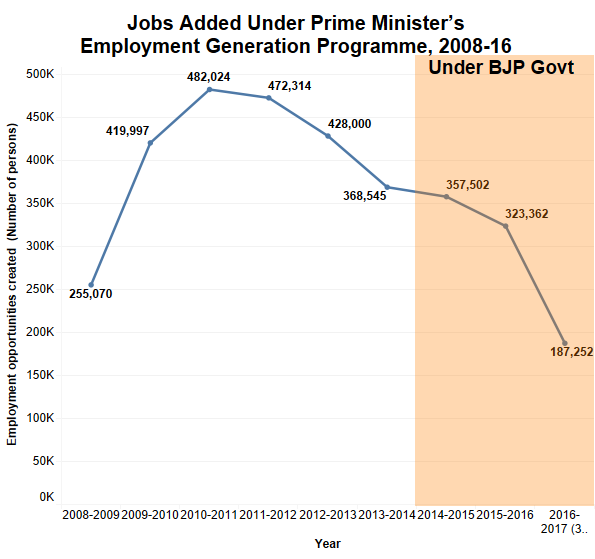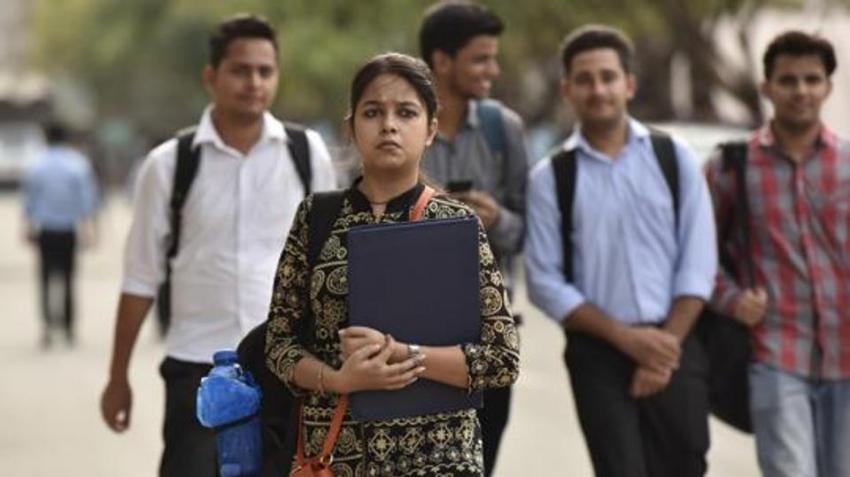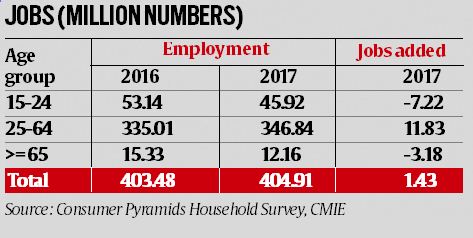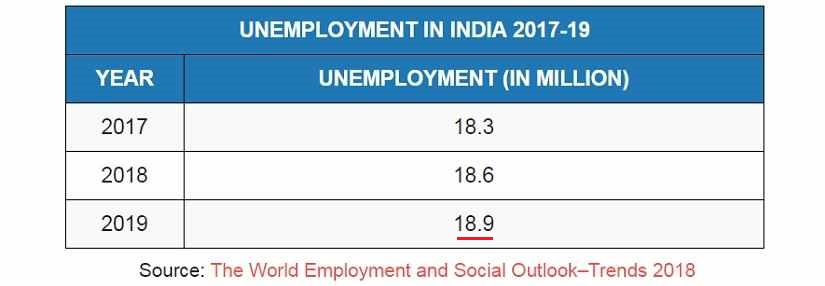On 15th August 2018 from the Red Fort on Independence Day, prime minister Narendra Modi on the issue of employment said- “My dear countrymen, 13 crore Mudra Loans has been a major achievement. More so, if it includes 4 crore youth who have taken the loan for the first time with the aspiration to become self-reliant and are promoting self-employment” but the government has made a joke of itself by contradicting their own stand on employment generation in last four years. It goes back to 2014 when Narendra Modi assumed power as India’s Prime Minister riding on the back of many promises. At least two of them were highly aspirational, and he also seemed vocal about them: a) to bring back black money & b) to create more jobs for people. At a rally in Agra in 2013, when he was campaigning for the position of PM, he had said that the BJP would create 10 million jobs: “If BJP comes to power, it will provide one crore jobs which the UPA Government could not do despite announcing it before the last Lok Sabha polls.” Since it also got an overwhelming majority, one would expect such promises are meant to be kept. In the recent past, there was interesting feedback from leaders of BJP which is nothing but a self-contradictory.
- Last month BJP President BJP President Amit Shah said that in the two years since MUDRA has been in existence, 7.28 crore people have become self-employed.
- In an interview to Swarajya, Prime Minister Narendra Modi said- “Jobs not lacking, the issue is lack of data on jobs”.
- In a reply to question on Maratha agitation for reservation by media, Nitin Gadkari conceded, “Even if reservation is given, there are no jobs. Jobs in banks have shrunk because of information technology. Government recruitment is frozen”.
This mixed bag of claims by top leaders of the BJP including the Prime Minister on employment generation is equal to farce underway these days.
MISLEADING MASTERSTROKE ON JOB DATA–
According to the Bureau of Labour and Statistics, 48 million people registered for employment in 2014, but less than 1% was given job placements by the exchanges. On the other hand, the officials of the Indian government, the PM, the ministers and government agencies are boasting about generating jobs in the lakhs every year.
In June, the government’s think tank, NITI Aayog claimed that 35 lakh new jobs were generated between September 2017 and February 2018. As per the data released by the retirement fund body, Employees’ Provident Fund Organisation (EPFO) and the Pension Fund Regulatory Development Authority (PFRDA), 35.3 lakh new payrolls were generated during this 6-month period. Even Prime Minister Narendra Modi said in a televised interview that the data on 7 million jobs was the result of a study.
The notion of the generation of new jobs by Modi government can be easily understood when one compares the Labour Participation Rate (LPR) and the EPFO enrollments which are the government’s prime source of this claim.
First of all, let us be clear that the EPFO data does not pertain to employment. The rise in EPFO enrolment largely indicates the conversion of the informally-employed workforce into formal employment. It can only be used to measure the extent of the formalisation of the workforce. Here, the workers who were unaware of the facility of a provident fund (PF) and were enrolled in the EPFO scheme were considered as a newly-registered workforce. But this cannot be termed as the generation of new jobs.
This does not mean that the EPFO data is not significant at all. But it should not be confused with employment data. Consequently, this calculation of 35 lakh new jobs is just misleading. On the other hand, the labour participation rate (LPR) is at its lowest, when compared with the rates in the previous years. During demonetization, a large portion of the workforce, consisting of millions, stopped working as daily-wage workers. A large number of labourers quit the labour market post demonetization, and have not returned back.
Was there any effort to bring back this workforce into the fold of the mainstream? A fresh CMIE report clearly states, “Labour participation rate (LPR) declined in April 2018. At 43.1%, the LPR in April was among the lowest. In the past 28 months, (since the CMIE started measuring LPR), this was the second-lowest LPR level.”
RISING UNEMPLOYMENT- According to a Firstpost report, “As many as 18.3 million Indians were unemployed in 2017, and this unemployment is projected to increase to 18.9 million by 2019, according to The World Employment and Social Outlook–Trends 2018 report by the International Labour Organisation, released on 22 January 2018.” And according to yet another report, “In February 2018, around 41 million people were competing for 1.6 million jobs posted at employment exchanges across India. The number of unemployed seeking jobs has doubled from around 3% in 2015 to 7% in early 2018.”
The Economic Survey too considers job generation as the biggest challenge. The organised sector does not seem to be hiring people directly. It prefers contract labour. Furthermore according to a Hindustan Times article, “The number of beneficiaries of one government assistance programme, the Prime Minister’s Employment Generation Programme (PMEGP)–which aims to generate employment in rural and urban areas by starting new micro enterprises and small projects–has fallen 24.4% from 428,000 in 2012-13 to 323,362 in 2015-16, according to government data. Until October 2016, the programme had created an additional 187,252 jobs, according to the latest data available.”

The fresh analysis of Centre for Monitoring Indian Economy (CMIE) states there is a dip in labour participation rate (LPR), “The labour force fell from 439.7 million in 2016-17 to 426.1 million in 2017-18. The labour force participation rate fell from 46.1 per cent to 43.5 per cent. It is the labour force participation rate that is a better measure of the labour market conditions in India. It is not good if the number of people willing to work declines. It is not good if an increasing proportion of the working-age population expresses no interest in working. But, this is what happened in 2017-18.” Renowned economist and former Chief Economic Adviser to the Government of India, Kaushik Basu recently in an interview to The Hindu said, “My immediate concern is the job situation. It is true that we don’t have detailed data on employment. But whatever piecemeal numbers are coming out suggest that unemployment and underemployment are growing. The small producers and the informal sector have done poorly over the last two years, and both agricultural and manufacturing have been performing poorly.”
With the giant rising threat of unemployment, Modi government’s seriousness is questionable at time when Labour ministry’s decision to suspend quarterly employment survey (QES) in the organized sector has come in. According to senior labour ministry official, the QES was put on hold as the government decided to make the payroll date exercise a regular one. This makes no sense and puts a big question on ignorance and fraud attitude of the Government.
Modi government has played a good political gimmick on the promise of giving employment and employment data. In simple words, for a country like India with a humungous young population, absence of employment is a mockery of the needy mass. The abysmal set of suicidal policies certainly is not serving us with the solution named employment. Instead of providing jobs, leaders of the ruling party-Amit Shah, Tripura’s Chief Minister Biplab Deb and Prime Minister Modi shamelessly boast on suggesting all to sell pakoda, cow milk. If this only was to be done, then why Modi government should not be held accountable for bluffing millions?
Disclaimer: The opinions expressed in this article are the personal opinions of the author. The facts and opinions appearing in the article do not reflect the views of NEWSD and NEWSD does not assume any responsibility or liability for the same.




















